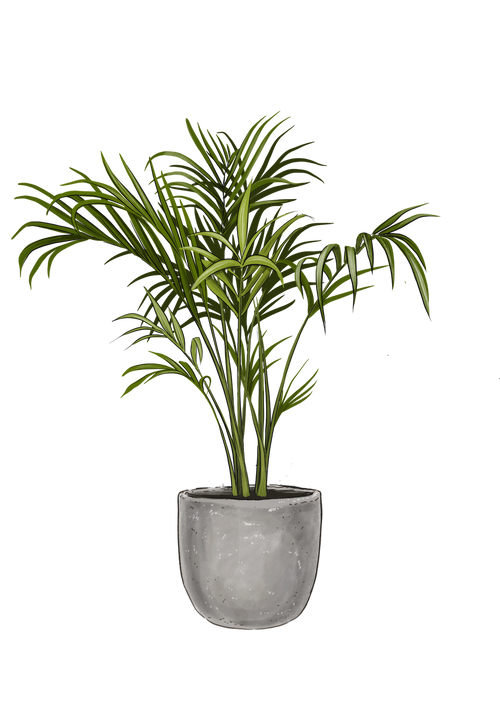Welcome
You have points
Recently viewed
No recently viewed items
Wishlist
Sign in to access your favorites

Medium to bright indirect light.
Keep the soil moist consistently (but not soggy).
Spritz daily
This plant loves heat and humidity so the warmer the better. Keep away from heating vents or direct sunlight though as the leaves could burn.
Outdoors in part sun (4-6 hours), where nights are above 40°F.
Interior: Feed the Cat Palm monthly in the spring and summer months and reduce to once or twice during the fall and winter months. :: Exterior: Apply fertilizer around the drip line of the plant and follow manufacturer's directions for use. Apply in three times a year in the spring, summer and fall.
Repotting details
Cat Palms like to be rootbound, so don't repot until the roots grow out of the pot's holes. When the plant is rootbound and ready to repot (early spring before growth starts), plant in a 2" bigger container in diameter and slightly deeper than the existing planter.
Use an indoor container mix that is well-draining with good aeration. You may add peat moss to the soil to keep them light.
Add soil to the bottom to elevate the root clump.
Lift the plant and inspect the root clump. Notice if there are any dead or rotting roots and trim off with sterile pruners. If the plant is rootbound, cut through the roots to alleviate continued encircling.
Ensure the plant is sitting about 1" below the edge of the pot to avoid water spillage. Add more soil and backfill around the sides by tamping down. Do not cover the current level of soil on the plant but add soil up to this level.
Water thoroughly, leaving the soil damp but not soggy. Add more soil after watering if the soil settles.
After transplanting, the Cat Palm may experience some transplant shock after the process. Allow the palm to rest during this time in a partial shady area if outdoors or bright, indirect light when indoors.
Keep them well-watered and add humidity around them as they are getting established.
Outdoors:
Before planting or repotting in a container, water the plant in the grower pot well and let drain.
Find a spot in the garden where there are at least 4-6 hours of direct sunlight each day.
Be generous by digging a hole twice the pot's width and 1 inch shorter than the grower pot to raise them above the soil level for good drainage.
Use a pitchfork or a sharp object to stab the soil walls to make several indentions for the roots to take hold.
Tickle the roots to loosen them if they wrap inside the container. Place the plant in the center of the hole. Fill the hole with water first, so the roots get another good drink.
Next, backfill with native soil mixed with compost by one third to one half (if the native soil is clay).
Add a rooting hormone fertilizer to this backfill mixture.
Tamp the soil firmly down around the edges and mound up. Avoid covering the original soil level of the plant that was in the container.
Add mulch as needed but not next to the stem or branches of the plant. Water and keep consistently moist but not soggy. Continue to observe the soil moisture each day, depending on the temperatures and soil drainage.
Keep yellowing or browning fronds cut off. If tips get burned, trim off the edges at an angle so they looks more natural. Keep the soil clean and replenish with soil if depleted.
Divide your palm by dividing the established plant. Remove the clump from the container after watering to help loosen the soil. Wash off the soil and gently brush away the soil from their roots. Identify where the stalks are attached to the roots. Take a sharp, sterilized garden knife and split the clump in half or thirds. Keep the knife disinfected as cuts are made throughout the root system to avoid spreading diseases.
You can also remove suckers that grow straight upward from the root ball. Loosen the soil away from the roots and separate the sucker from the mother plant. If needed, cut the roots away from the clump carefully. Follow our potting instructions to keep your new baby plant happy!